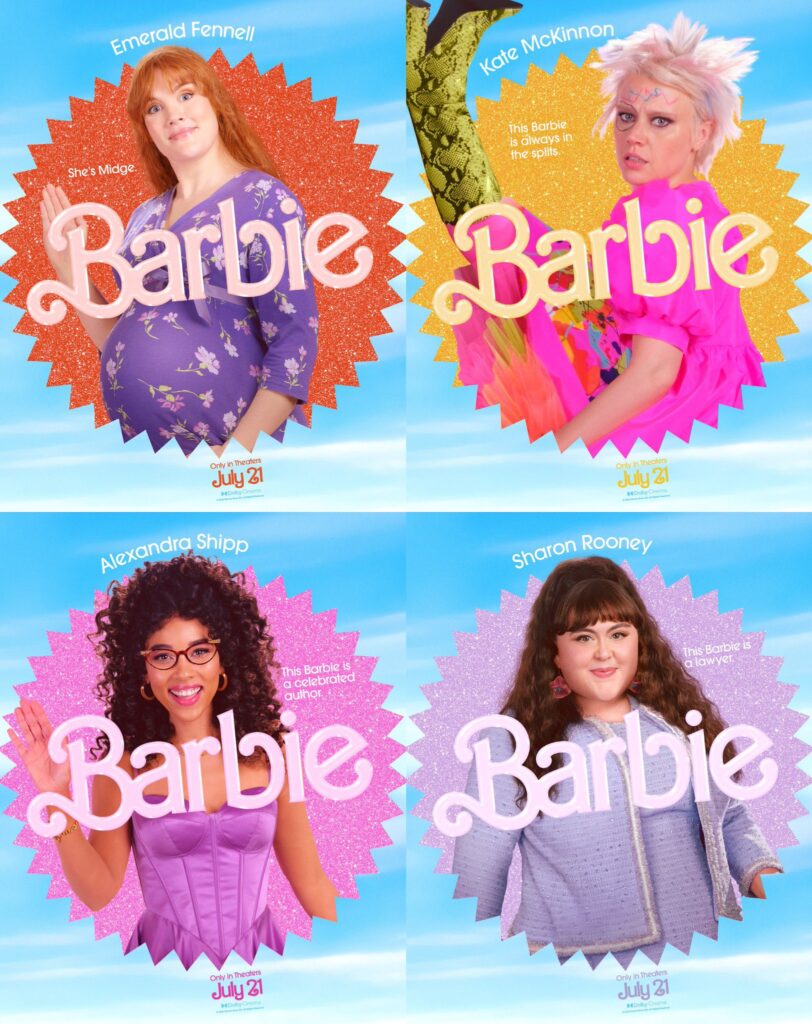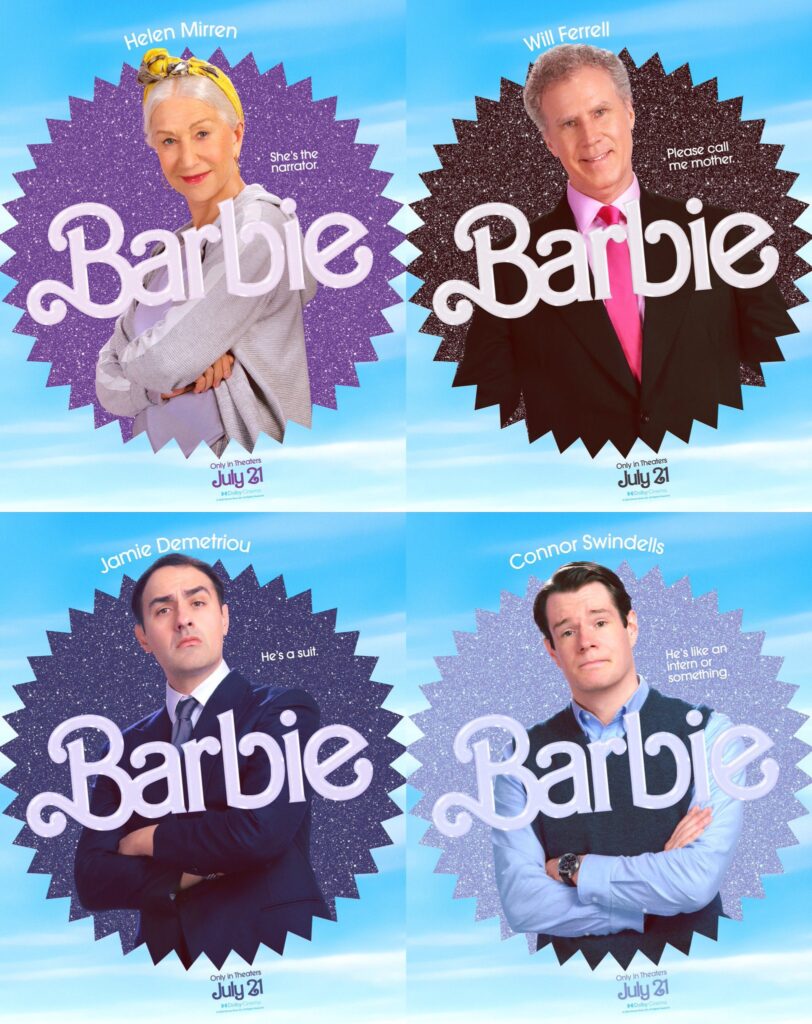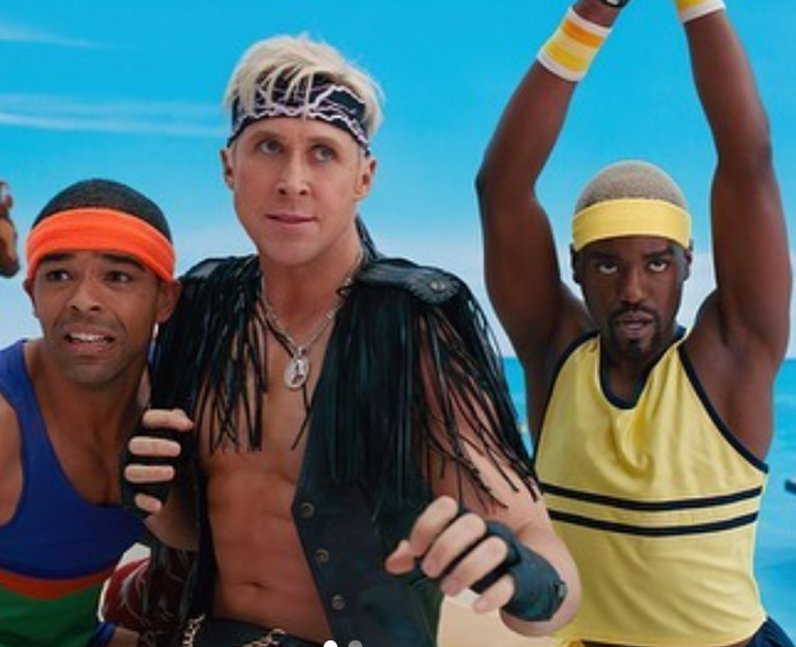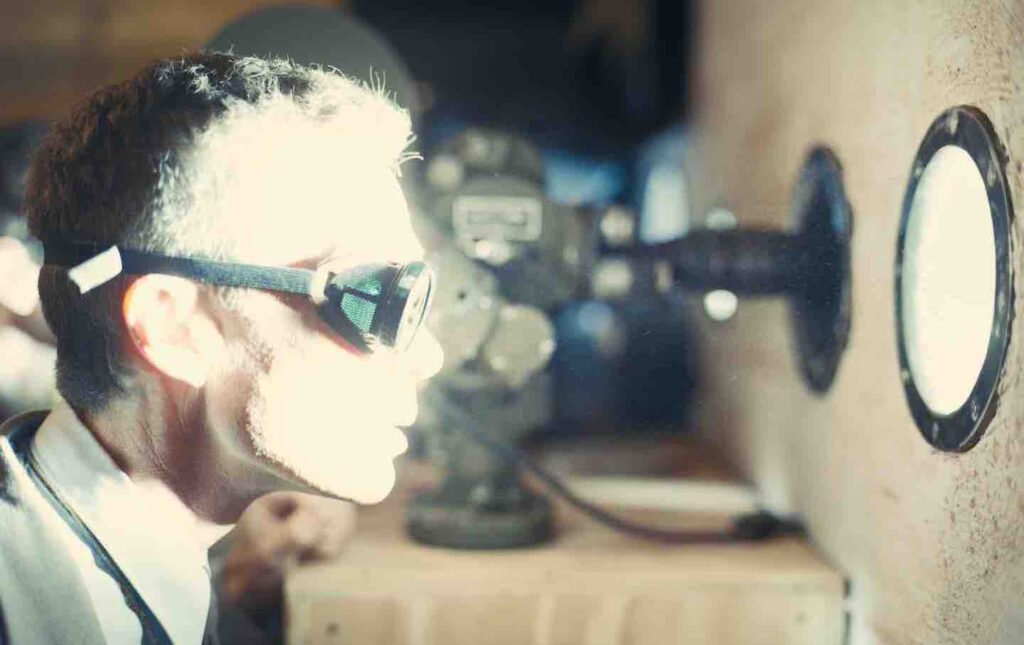Reviewed by Tim Robins
So, I took the challenge to see Barbie and Oppenheimer on the same day; Barbie first (10.00am) and Oppenheimer later (1.50 pm). And I strongly recommend seeing the films in that order, as Oppenhiemer is likely to leave you too exhausted and troubled to see another film.

The Barbenheimer challenge to see both films on one day has succeeded in making going to the cinema an event again with the i newspaper (24/07/2023) reporting the two films “have delivered the biggest weekend for UK cinemas since the pandemic with screenings for both films selling out”. I saw Barbie first because it was the earlier screening and Oppenheimer only after a proper break for lunch. Don’t try to survive only on cinema snacks and cookies and cream frappe.






Barbie works best as a candy-pink appetiser, rather than a tasty dessert. There are fun songs, sight gags and knowing product placement – the real world is reached by a range of Barbie vehicles. The script has references to other movies, including Zack Snyder’s Justice League. Adults accompanying children will certainly have some explaining to do, as, in a drop the mic moment, Barbie (Margot Robbie) demands to see a gynaecologist!
One theme that provides the most heartfelt moments in the film is Barbie’s acceptance that real life entails birth and death. My favourite moment in the film has Barbie sharing a bench with an elderly woman. “You’re beautiful,” Barbie says – a scene that director Greta Gerwig fought to keep in the film in the face of studio insistence that it should be removed. In contrast, Barbieland’s ostracisation of Midge (Pregnant Barbie) is so throw away that it fails to foreshadow Barbie’s existential questioning of what is good or bad about being real.

Barbie is fun, but, in my view, it could have been funnier. Director and co-script writer Greta Gerwig has delivered a thoughtful film with a sense of humour reminiscent of Zoolander (2001), an impression enhanced by casting Will (Mugatu) Farrel as the CEO of Mattel. And as a dramatisation of a line of Mattel toys, Barbie is a world away from Cannon’s disappointing He-Man and the Masters of the Universe, although both involve toys crossing over into our world. At times, I wished John Waters (Hairspray, Cry Baby etc.) had made a Barbie movie back in the 1980s. I can’t help feeling it would have been a more outrageously challenging piece of cinema.
Barbieland is a pink utopia in which Barbies work and govern and Kens just hang about on the beach. The conceit is that the toys’ lives are shaped by the girls who own and play with them in the real world, a place imagined as reflecting Barbieland by being an emancipated paradise for women.
“Stereotypical Barbie” (sic) – played my Margot Robbie – learns the terrible truth when she travels to reality to discover why her happy mind is being plagued with thoughts of death and her body starts mutating off-model. Barbie must learn to stand on her own two feet as she seeks out her troubled owner in the real world.

The lead Ken (Ray Gosling, in perfectly plastic form) has his own adventure, changing from Barbie’s clinging, unrequited boyfriend to introducing patriarchal power to Barbieland, although he believes patriarchy involves a love of horses. At the same time, the CEO of Mattel is desperately trying to put Barbie back in her box. Yes, that is actual and metaphorical. Ho ho.
I’ve seen reactions from people (who clearly haven’t seen the film) suggesting Barbie is a finger wagging world of “woke”. It isn’t. Instead, by emphasising the importance of the way girls play with Barbie dolls, the film argues that the dolls don’t determine children’s identities but serve as material for acting out identities other than those suggested by Mattel’s marketing.

We are even introduced to “Weird Barbie”, a doll who has been “over-played” by a child and now lives the life of a wise but wacky hermit. Toy Story was better at envisaging the fate of such toys. I was surprised “Weird Barbie” still had legs to walk on. Destroying your Barbie doll seems to have been a rite of passage for many young girls.
There’s no doubt Barbie was a vital part of the wall of pink at Toys R Us, just as He-Man and The Masters of the Universe helped colour boyhood in shades of green and purple. I recall, not for the first time, flicking through an Argos catalogue and trying to persuade a friend’s young daughter to choose GI Joe and his compatriots for Christmas. In the end, she put her hands on her hips and scolded me, “Tim! I am a little girl!” So pink can play a meaningful part in children’s gender identity. The trouble comes when little girls do want to imagine themselves as heroic adventurers.
Barbie does address the relationship between cultural norms embodied in toys and children’s sense of self without losing a sense of fun. There are a surprising number of references to existentialism, and trying to navigate such positions makes the third act exposition heavy. Disappointingly, Gerwig falls back on piffle, around being all you can be, being true to yourself and having aspirations beyond those suggested by society. This is philosophy seen through the lens of the Oprah Winfrey show or from the balcony of a dollhouse.
If you grow up aspiring to be a “stereotype”, well, that’s just fine. Except it’s not; particularly if it involves, for instance, pre-pubescent boys battering their biologies with steroids to try and realise a masculine ideal through bodybuilding. As Emily Robinson, UK Anti-Doping’s Director of Strategy and Education said: “Steroid abuse in the UK is now a serious public health issue. Social media and TV are more and more dominated by unrealistic body types, which we know leads to young people trying to emulate these. Young men in particular, aged 20-24, are being lured into a false reality and begin to rationalise their choices, by convincing themselves that their new and so-called improved look outweighs the risks”.
I recall a show on ITV in which an American female representative of Mattel told an audience of British mothers that surely all girls aspire to be tall, blonde and beautiful. The argument didn’t go down well -”No, they don’t!”. Today, gender identity remains a hot topic and far from being “woke”, Barbie is rather conservative. The film reminds us that attempts to expand the actual toy line have not been particularly successful. Who remembers Allan, marketed as Ken’s friend, and played here by the spot-on Michael Cera?

But wearing a polo shirt is about as divergent as the characters get. Doctor Who fans will spot Ncuti Gatwa as a Black Ken, who isn’t given many lines but is at least in the picture. But walking out of the cinema and onto the streets of Brighton, whose population can identify as non-binary or intersex or transgendered or gender queer, the world of the Barbie movie seemed decidedly dated. Sometimes the film’s script feels less like playing with a doll and more like trying to resolve a Rubrik’s cube with colours missing on some of the squares.
According to a poll shared by YouTuber Rationality Rules, about 70 per cent of philosophers think gender is a social, rather than a biological, category. Then again there have been famous philosophers who are not sure an external reality exists beyond our thoughts. While watching Christopher Nolan’s Oppenheimer, a biopic about J Robert Oppenheimer, the father of the Atom Bomb, I wondered what percentage of physicists working on “The Manhattan Project” actually thought the bomb might set fire to the Earth in an uncontrollable nuclear reaction. As it turns out, probably none.
A report by three Manhattan Project scientists in 1946 stated that no self-propagating chain of nuclear reactions was likely to occur because “The energy losses to radiation always overcompensate the gains due to the reactions”. According to an article in from the website Discover, by the time Enrico Fermi jokingly took bets among his Los Alamos colleagues on whether the July 16, 1945, Trinity test would wipe out all earthbound life, physicists already mathed out the probability of setting the atmosphere on fire.
Then again, the myth that scientists working around the test site at Los Alamos could have unintentionally blown the world up persists in the popular imagination and was according to Nolan the spark that fired the director’s ambition to make this movie. It also adds suspense to a movie that otherwise is about men in suits talking in rooms.


Good gracious, Oppenheimer is dull. But only in retrospect. Watching the film is absolutely gripping. The cast plays a major role in this, totally subsuming their star personas into the characters they play. At the centre of it all is Cillian Murphy’s Oppenheimer, intensely intellectual, an observer of his own, politicised social scene and, at times, arrogant and inept at reading a room. Protected by his parent’s wealth and surrounded by the brightest minds quantum physics had to offer, Oppenheimer is unprepared to meet the world outside his circle head-on.
There are great performances here. Robert Downey Jnr brings a simmering anger to his portrayal of Oppenheimer’s covert rival Lewis Strauss, a businessman, philanthropist, and member of the Atomic Energy Commission. An almost unrecognisable Gary Oldman plays the intemperate President Truman, who dismisses Oppenheimer as a cry-baby and dismisses his moral concerns out of hand. Truman told his Under Secretary of State: “I don’t want to see that son-of-a-bitch in this office ever again”.
In life, Oppenheimer’s fall from grace culminated in a security hearing into his political affiliation. It’s a glum affair to watch. In part, the hearing was the result of the House of Un-American Activities Communist witch hunts. Ironically, Oppenheimer had never joined the Communist Party and even testified before the Committee, naming Party members of his acquaintance.
The film returns to the Security Hearing again and again. Emily Blunt, who plays Kitty Oppenheimer and brings a much-needed waspishness to her testimony. Apparently, many of Blunt’s lines come from a transcript of the proceedings themselves. In 1953, Oppenheimer’s security clearance was withdrawn, a mere one day before it was due to lapse anyway. That decision was only “vacated” in 2022, a decision thought to be hastened by the impending release of Nolan’s film.
There’s no doubt that Robert Oppenheimer felt burdened by the forces he had helped unleash on the world, but at the time he was very much a “hawk”. Nolan includes a speech in which the scientist tells workers at Las Alamos that he wished Nazis were still in the war, so they could drop the bomb on Germany. Oppenheimer relives the scene as a nightmare.
We don’t see the victims of the bombs, but Nolan brings it home in dreams, in which Oppenheimer sees his friends destroyed by heat from the bomb and suffering radiation sickness. It is worth remembering that Oppenheimer thought a nuclear bomb dropped over a city would kill around 20,000 people. In reality, the bombs that fell on Hiroshima and Nagasaki are estimated to have killed between one hundred thousand, to two hundred thousand people.


My favourite reaction to the test was from the American physicist Kenneth Bainbridge, who turned to Oppenheimer and said, “Now we are all sons of bitches! More famously, Oppenheimer himself would recall, a passage from the Bhagavad Gita; As Oppenheimer says, “Vishnu is trying to persuade the prince that he should do his duty, and to impress him, takes on his multi-armed form and says, ‘Now I am become Death, the destroyer of worlds’”. Out of context, these words, which even appear on the film’s poster, seem arrogant. Is Oppenheimer comparing himself to a god? Possibly not.
Apparently, Oppenheimer’s recollection of the line’s from the Bhagavad Gita included, “If the radiance of a thousand suns were to burst at once into the sky, that would be like the splendour of the mighty one”. So Oppenheimer was talking about the effect of the bomb, it was the intense light and resulting mushroom cloud that looked like a “thousand suns” that “burst at once”. The explosion was like looking at the face of a god and it is the god describing himself as a destroyer of worlds.
Even the word death seems to have been a mistranslation by Oppenheimer’s teacher. Apparently, “Death” should be translated as “Time-Destroying”. This is somewhat fitting given Nolan’s own interest in breaking time’s arrow. At times it is as if the entire narrative has been ripped up into confetti, and the weird light effects supposed to represent nuclear forces are an unhelpful distraction.
Fortunately, Nolan pulls the plot together and the effect of returning to scenes gives them a new meaning, particularly a moment when Oppenheimer confides in Einstein by a pond. What are the two talking about? Strauss becomes obsessed with the moment and, when Einstein brushes past him, becomes convinced that Oppenheimer has turned Einstein against him. Nolan has a good grasp on “office politics”.
There is one way Barbie and Oppenhiemer are related. The end of World War Two and America’s victory led, against predictions, to a massive consumer boom. In the US, Gross Domestic Product increased from $228 billion in 1945 to just under $1.7 trillion in 1975. As Sarah Pruitt (2020) for History notes, “With the war finally over, American consumers were eager to spend their money on everything from big-ticket items like homes, cars and furniture to appliances, clothing, shoes and everything else in between”.
In retrospect, it is a shame people bought Barbies and Kens to play ‘Doctors and Nurses’, rather than spend the money on an actual health service.
Tim Robins
• Barbie and Oppenhiemer are in cinemas now. You know you want to.
• Barbie (search for “Barbie” on Google and your screen turns pink, as of publishing this!) is online at warnerbros.co.uk/movies/barbie | The film gets a release on Blu-ray and DVD in December (AmazonUK Affiliate Link)
• Oppenheimer is online at oppenheimermovie.co.uk (don’t worry, nothing explodes if you search for it)
A freelance journalist and Doctor Who fanzine editor since 1978, Tim Robins has written on comics, films, books and TV programmes for a wide range of publications including Starburst, Interzone, Primetime and TV Guide.
His brief flirtation with comics includes ghost inking a 2000AD strip and co-writing a Doctor Who strip with Mike Collins. Since 1990 he worked at the University of Glamorgan where he was a Senior Lecturer in Cultural and Media Studies and the social sciences. Academically, he has published on the animation industry in Wales and approaches to social memory. He claims to be a card carrying member of the Politically Correct, a secret cadre bent on ruling the entire world and all human thought.
Categories: Features, Film, Other Worlds, Reviews

 In Review: Twisters
In Review: Twisters  In Review: Kingdom of the Planet of the Apes
In Review: Kingdom of the Planet of the Apes  In Review: Rebel Moon Part 2 – The Scargiver
In Review: Rebel Moon Part 2 – The Scargiver  In Review: Civil War
In Review: Civil War